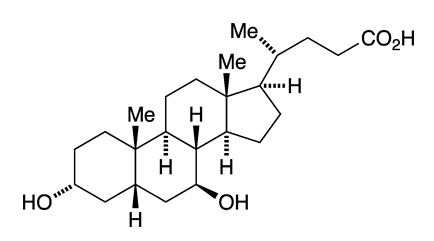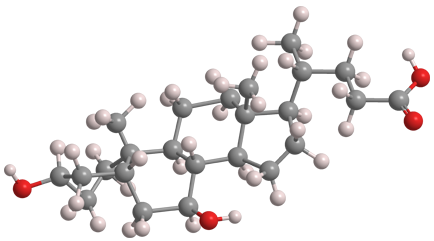What molecule am I?


Ursodeoxycholic acid (UDCA) is a secondary bile acid, which means that it is a bacterial metabolite of primary bile acids produced in the liver. It is a C7 epimer of chenodeoxycholic acid, one of the two primary human bile acids.
M. Shoda, a Japanese researcher, first isolated UDCA from bear bile in 1927. (UDCA takes its name from ursus, the Latin word for bear.) Two years later, K. Kaziro, also in Japan, determined its structure.
UDCA has several medical uses, including
- reducing or preventing gallstones, often in patients who have had bariatric surgery;
- treating primary biliary cholangitis, an autoimmune liver disease; and
- improving bile flow in newborns with impaired flow.
UDCA also goes by the generic name ursodiol. It is manufactured from cholic acid (the other primary human bile acid) by Industria Chimica Emiliana (ICE, in Reggio Emilia, Italy). ICE was recently acquired by Advent International, a private equity firm based in Boston.
Ursodeoxycholic acid hazard information
| GHS classification*: not a hazardous substance or mixture |
*Globally Harmonized System of Classification and Labeling of Chemicals.
Ursodeoxycholic acid
fast facts
| CAS Reg. No. | 128-13-2 |
| Empirical formula | C24H40O4 |
| Molar mass | 392.56 g/mol |
| Appearance | White crystals or powder |
| Melting point | 203 ºC |
| Water solubility | 20 mg/L |

Learn more about this molecule from CAS, the most authoritative and comprehensive source for chemical information.
Molecule of the Week needs your suggestions!
If your favorite molecule is not in our archive, please send us a message. The molecule can be notable for its current or historical importance or for any quirky reason. Thank you!
Stay Ahead of the Chemistry Curve
Learn how ACS can help you stay ahead in the world of chemistry.

